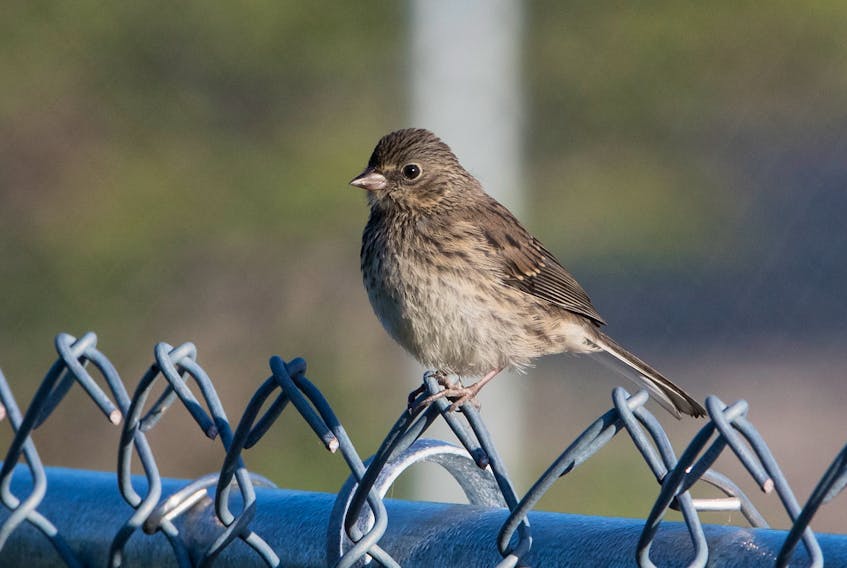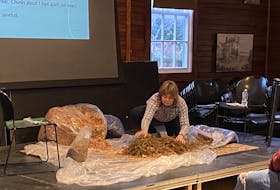We are riding high on the crest of summer. Everything is as green as green can be. The barrens and headlands never looked so beautiful as they do now, in a coat of rich green. The fiery pink flowers of the fireweed are showing strong, always a bonus in maturing summer.

There are not many active bird nests remaining by mid-August. There are a few exceptions, as some juncos are still bringing off their second brood of the summer. American goldfinches and cedar waxwings typically nest late in the summer, for good reasons. The goldfinches are waiting for some of the flowering plants to go to seed. The fine seed is served to the new little goldfinches. Cedar waxwings are not ready to nest until the first ripe berries appear on the chuckley pear shrubs in August, so the young will have something to eat when they get out of the nest.
There are so many new young birds out on their own now, exploring and learning about the great big world outside their home nest. Groups of young sparrows of different species flock together in social groups. As a loosely associated gang they rove about the weed patches in the clearings and along the edge of the woods. Insect food and grass seeds are present in abundance in late summer. Young warblers also form little groups all focused on learning the ropes of living independently of their parents. They are learning to feed themselves while keeping safe from dangers.
During those first few weeks after leaving the nest the young birds are in a unique plumage that more or less resembles their parents but can be quite different. Sometimes so different that the juveniles can befuddle birders. Every year during August I am sent pictures of mystery birds. Often it is a photograph of a common bird that people know so well but were unfamiliar with them in the juvenile plumage.
The classic example is the yellow warbler, a common summer bird very well known to all active birdwatchers. However, the juveniles are different dressed in dull yellow with large patches of gray feathering. Birders do not get much chance to learn about yellow warblers in this plumage and it is rarely mentioned or illustrated in the bird guides.
There are so many new young birds out on their own now, exploring and learning about the great big world outside their home nest.
A common identification pitfall is the juvenile swamp sparrow. The juvenile swamp sparrows show plenty of fine striping on the breast and sides that the adults do not have. This makes them look more like a Lincoln’s sparrow than a swamp sparrow. Luckily, these confusing juvenile plumages last only for three or four weeks. You may have noticed robins with a spotted breast. These are the young of the year. Those spots will be gone by September when they will look identical to the adults. Even the everyday junco looks like a different species in its juvenile period. See the picture with this column showing a juvenile junco in its streaky brown plumage.
Even the most experienced Newfoundland birders can be momentarily stumped by a juvenile plumaged bird. Such was the case when Richard Thomas came across an odd gull in Trepassey that did not register as anything familiar at first. The small dark brown gull was a laughing gull. This species is rare but annual in summer in Newfoundland. They always have grey backs and wings when they visit Newfoundland, but this bird did not have a hint of grey anywhere. It was an all-brown juvenile. We are guessing it must have just left its home nesting site somewhere on the east coast of the United States and rode the southwest winds to the Avalon Peninsula. By September those brown juvenile feathers will be replaced by smooth cool grey feathers.
SUBHEAD: Rarities of the week
I only heard of one rare bird found this past week. It was the western kingbird that flew by Vernon Buckle at Forteau, Labrador. This western member of the flycatcher family strays to Eastern Canada a few times every fall, but usually in October or November. An early August bird threw us for a loop. Vernon’s photos in flight were just good enough to confirm that it was not some other even rarer species of exotic flycatcher.
The rare bird hunting season ramps up in late August. It is full open season for rarity hunters from September to November. There is no bag limit. You can shoot all you want with your camera and bring home the trophies to share with your friends. Every week during bird migration at the end of summer, and all through the fall, brings us new possibilities. Birds are on the move.
Bruce Mactavish is an environmental consultant and avid birdwatcher. He can be reached at [email protected]. His column returns in two weeks.
RELATED:









